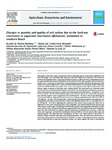Use este identificador para citar ou linkar para este item:
http://www.alice.cnptia.embrapa.br/alice/handle/doc/1065652Registro completo de metadados
| Campo DC | Valor | Idioma |
|---|---|---|
| dc.contributor.author | BORDONAL, R. DE O. | pt_BR |
| dc.contributor.author | LAL, R. | pt_BR |
| dc.contributor.author | RONQUIM, C. C. | pt_BR |
| dc.contributor.author | FIGUEIREDO, E. B. DE | pt_BR |
| dc.contributor.author | CARVALHO, J. L. N. | pt_BR |
| dc.contributor.author | MALDONADO JUNIOR, W. | pt_BR |
| dc.contributor.author | MILORI, D. M. B. P. | pt_BR |
| dc.contributor.author | LA SCALA JUNIOR, N. | pt_BR |
| dc.date.accessioned | 2017-03-01T11:11:11Z | pt_BR |
| dc.date.available | 2017-03-01T11:11:11Z | pt_BR |
| dc.date.created | 2017-03-01 | pt_BR |
| dc.date.issued | 2017 | pt_BR |
| dc.identifier.citation | Agriculture, Ecosystems and Environment, v. 240, p. 54-65, 2017. | pt_BR |
| dc.identifier.uri | http://www.alice.cnptia.embrapa.br/alice/handle/doc/1065652 | pt_BR |
| dc.description | Soil organic carbon (SOC) plays an important role for soil quality and its conservation is affected by the land-use change (LUC) associated with sugarcane (Saccharum officinarum) expansion. This study was based on the hypothesis that: (i) LUC from perennial crops (e.g., coffee and citrus) and extensive pasture to sugarcane plantation results in depletions of soil carbon (C) stock and its quality; and (ii) transition of annual crops to sugarcane increases soil C stock and improves its quality. Therefore, the objective of this study was to assess changes in soil C stocks and the humification levels of soil organic matter (SOM) upon conversion of different land uses (coffee, citrus, annual crop and pasture) into sugarcane plantation in the Mococa region, northeast of São Paulo state, southern Brazil. The experiment was conducted within commercial farms and experimental design is comprised of a farming system involving four scenarios of land-use transition to sugarcane (e.g., paired areas). Soil samples were collected to a 1-m depth (0?10,10?20, 20?60 and 60?100 cm), and the equivalent layers of 0?20 and 0?100 cm were obtained for each paired area. SOC decreased in 3 years ranged from 124.5 to 99.8 Mg C ha-1 for the 0?100 cm layer following the conversion of coffee to sugarcane. Conversion of citrus to sugarcane depleted soil C stock from 147.7 to 113.1 Mg C ha-1 for the 0?100 cm layer after a 4-year period. Conversion of pasture into sugarcane was comparatively less adverse in terms of soil C stocks, with depletion only for the 0?20 cm layer from 30.3 to 17.0 Mg C ha-1 in 8 years. Regarding the conversion from annual crop to sugarcane, there was no difference in soil C stock among land uses at any soil depths. Laser-Induced Fluorescence Spectroscopy (LIFS) showed a high stage of humification of SOM with increase in the magnitude of depletion of soil C stock, and vice versa. Increases in humification stages of SOM were observed from the top to the deepest layers for most of the land-use systems. Overall, conversions of perennial tree crops (e.g., coffee and citrus) into sugarcane increased the humification levels of SOM in sub-soil, except when sugarcane replaced pasture. The latter had lower humification of SOM in the surface layers of soil because of intensive tillage associated with sugarcane planting operations. Thus, the short-term maintenance of straw had a minor impact in improving soil C accumulation as well as reversing the increased oxidation level of SOM induced by sugarcane expansion. Further, our study suggests the need of assessing the impacts of LUC on soil C budget to deep sub-soil layers in agricultural systems. Finally, the data indicate that expansion of sugarcane over coffee and citrus agrosystems may impact the sustainability of ethanol production because of LUC-induced depletion of soil C stock and degradation of soil quality. | pt_BR |
| dc.language.iso | eng | eng |
| dc.rights | openAccess | eng |
| dc.subject | Sugarcane expansion | pt_BR |
| dc.subject | Laser-induced fluorescence spectroscopy | pt_BR |
| dc.subject | Sustainability | pt_BR |
| dc.subject | Espectroscopia de fluorescência induzida por laser | pt_BR |
| dc.subject | Sustentabilidade | pt_BR |
| dc.title | Changes in quantity and quality of soil carbon due to the land-use conversion to sugarcane (Saccharum officinarum) plantation in southern Brazil. | pt_BR |
| dc.type | Artigo de periódico | pt_BR |
| dc.date.updated | 2017-12-21T11:11:11Z | pt_BR |
| dc.subject.thesagro | Cana de açúcar | pt_BR |
| dc.subject.thesagro | Etanol | pt_BR |
| dc.subject.thesagro | Manejo do solo | pt_BR |
| dc.subject.thesagro | Matéria orgânica | pt_BR |
| dc.subject.nalthesaurus | Ethanol production | pt_BR |
| dc.subject.nalthesaurus | Soil management | pt_BR |
| dc.subject.nalthesaurus | Soil organic matter | pt_BR |
| dc.subject.nalthesaurus | Fluorescence emission spectroscopy | pt_BR |
| riaa.ainfo.id | 1065652 | pt_BR |
| riaa.ainfo.lastupdate | 2017-12-21 -02:00:00 | pt_BR |
| dc.identifier.doi | http://dx.doi.org/10.1016/j.agee.2017.02.016 | pt_BR |
| dc.contributor.institution | Ricardo de Oliveira Bordonal, FCAV/UNESP; Rattan Lal, Carbon Management & Sequestration Center, The Ohio State University, EUA; CARLOS CESAR RONQUIM, CNPM; Eduardo Barretto de Figueiredo, FCAV/UNESP; João Luís Nunes Carvalho, CTBE/CNPEM; Walter Maldonado Junior, FCAV/UNESP; DEBORA MARCONDES BASTOS PEREIRA, CNPDIA; Newton La Scala Junior, FCAV/UNESP. | pt_BR |
| Aparece nas coleções: | Artigo em periódico indexado (CNPM)  | |
Arquivos associados a este item:
| Arquivo | Descrição | Tamanho | Formato | |
|---|---|---|---|---|
| 4805AgrEcosysEnviron17.pdf | 1,44 MB | Adobe PDF |  Visualizar/Abrir |









